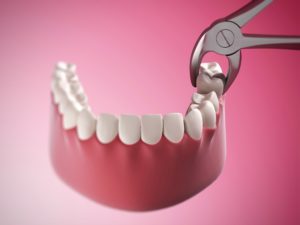What Does a Tooth Extraction Feel Like?
November 19, 2021
 Every tooth is crucial to a healthy, functional smile, which is why your dentist strives to preserve them. Although they try to save each tooth, extractions can be best in certain circumstances, such as impaction, denture preparation, or significant damage. No matter the reason, the thought of removing a tooth may make your palms sweat. There’s no reason to worry. Here’s what the procedure will feel like, so you know exactly what to expect during your tooth extraction.
Every tooth is crucial to a healthy, functional smile, which is why your dentist strives to preserve them. Although they try to save each tooth, extractions can be best in certain circumstances, such as impaction, denture preparation, or significant damage. No matter the reason, the thought of removing a tooth may make your palms sweat. There’s no reason to worry. Here’s what the procedure will feel like, so you know exactly what to expect during your tooth extraction.
Pain-Free Tooth Removal
Your dentist will keep you comfortable from start to finish. They’ll use a local numbing agent to prevent any pain during the tooth extraction. Some patients may also need a sedative, such as if a surgical extraction is necessary. Whether simple or surgical, you won’t have any pain as your dentist gets started. You will still feel certain sensations, like pressure, but there won’t be any pain.
After any numbing agents or sedatives have taken effect, your dentist will extract your tooth. A simple extraction requires rocking the tooth back and forth with forceps until it can be removed from the socket. If the tooth is partially or fully hidden below the gum tissue, a surgical extraction will be necessary. An incision is made in the gums to expose the tooth. It will be removed in small pieces, and your dentist will clean the surgical site before stitching it closed.
You will have a gap where the tooth used to be, which will be packed with gauze before you leave the dental office. You’ll have to bite on it for at least an hour to stop any bleeding. Slight bleeding can continue for a couple of days following the procedure.
Tooth Extraction Recovery
You can expect some discomfort after the local anesthetic or sedative wears off. You can manage it using a prescribed or OTC pain reliever. Applying ice packs to the outside of your face can reduce swelling and bruising.
Your dentist will review your aftercare instructions before sending you home, which can include a liquid diet, activity restrictions, or antibiotics. They will also advise you to skip vigorously rinsing your mouth, spitting, smoking, drinking through a straw, or blowing your nose to avoid dislodging the blood clot. If the clot is lost too soon, it can lead to a painful condition called dry socket.
You’ll also need to keep the extraction site clean. Although your mouth will be tender, you still need to brush and floss, but be careful when cleaning the healing tissue. Be sure to maintain any follow-up appointments. In a few days, you’ll be back to feeling yourself, and on your way to improved oral health.
About Dr. Jessica Henner
Dr. Henner earned her dental degree at the Stony Brook University School of Dental Medicine before continuing her education in general dentistry. Her experience in hospital-based oral healthcare allows her to treat several complex issues using advanced procedures. If you need a tooth extracted, contact our office today to schedule your consultation.
No Comments
No comments yet.
RSS feed for comments on this post.
Sorry, the comment form is closed at this time.


